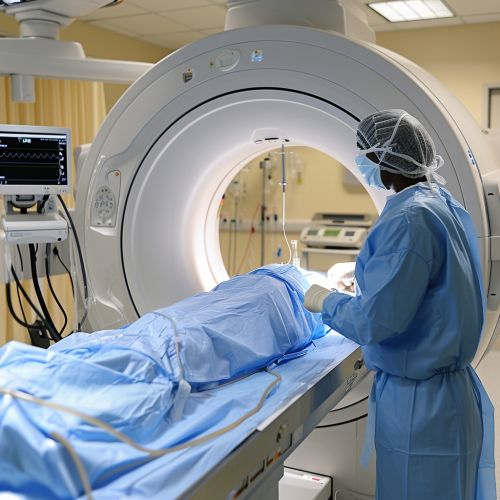Interventional Radiology
Overview
Interventional radiology (IR) is a medical specialty that performs various minimally invasive procedures using medical imaging guidance, such as computed tomography (CT), magnetic resonance imaging (MRI), ultrasound, and fluoroscopy. These procedures are typically less invasive and much less costly than traditional surgery. The field of IR has grown rapidly over the past few decades due to advancements in imaging technology and device miniaturization.


History
The field of interventional radiology was born in the early 1960s with the work of Charles Dotter, who is often referred to as the "father of interventional radiology". Dotter pioneered angioplasty and the catheter-delivered stent, which were initially used to treat peripheral artery disease. Since then, the field has expanded to include a wide range of procedures, including those for the treatment of cancer, vascular diseases, and more.
Procedures
Interventional radiology procedures are typically performed using needles and narrow tubes called catheters, rather than large incisions. Some of the most common procedures include angiography, angioplasty, stent placement, embolization, thrombolysis, biopsy, and ablation.
Angiography
Angiography is a diagnostic procedure that uses X-rays to visualize the blood vessels. During an angiogram, a contrast agent is injected into the patient's bloodstream to highlight the vessels on the X-ray images.
Angioplasty and Stent Placement
Angioplasty is a procedure used to open blocked or narrowed blood vessels. A small balloon is inflated inside the vessel to widen it, and a stent may be placed to keep the vessel open. This procedure is commonly used to treat conditions such as coronary artery disease and peripheral artery disease.
Embolization
Embolization is a procedure that blocks blood flow to a specific area of the body. This can be used to control or prevent bleeding, or to cut off the blood supply to a tumor. Various agents can be used for embolization, including coils, particles, glue, or drugs.
Thrombolysis
Thrombolysis is a procedure that dissolves blood clots. This can be done using drugs (pharmacological thrombolysis) or mechanically with a catheter (mechanical thrombolysis).
Biopsy
A biopsy is a procedure that removes a small sample of tissue for examination under a microscope. Interventional radiologists can perform biopsies of many different parts of the body, often using imaging guidance to ensure accurate placement of the biopsy needle.
Ablation
Ablation is a procedure that destroys abnormal tissue, such as tumors. This can be done using various methods, including heat (radiofrequency or microwave ablation), cold (cryoablation), or chemicals (chemical ablation).
Training and Certification
In order to become an interventional radiologist, a physician must first complete a residency in diagnostic radiology, followed by a fellowship in interventional radiology. The physician must then pass a board certification exam in interventional radiology. The training and certification process is overseen by various organizations, including the American Board of Radiology (ABR) and the Society of Interventional Radiology (SIR).
Future Directions
The field of interventional radiology continues to evolve, with new procedures and technologies being developed all the time. Some of the most promising areas of research include the use of nanotechnology for targeted drug delivery, the development of new imaging techniques for improved guidance during procedures, and the use of artificial intelligence to aid in diagnosis and treatment planning.
